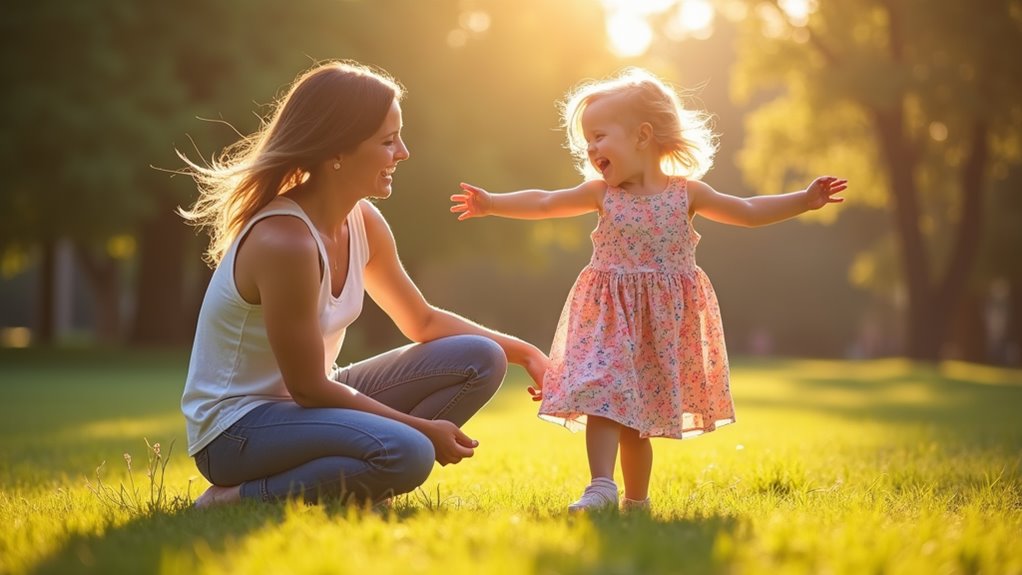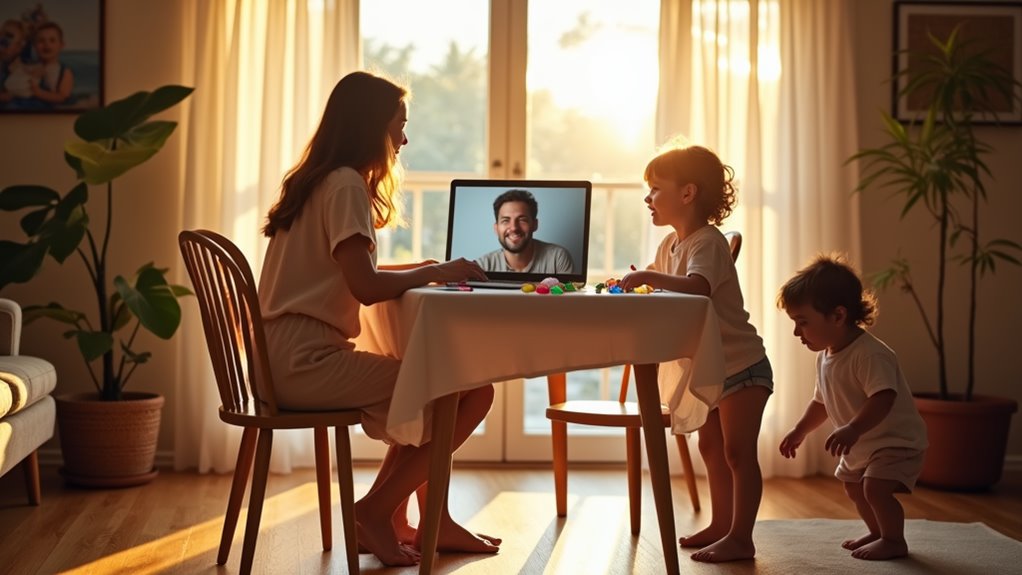Nonverbal cues are super important in connecting with your child. They help express feelings that words just can't, like a smile or a hug saying "I care" without saying a word. Paying attention to body language, eye contact, and gestures shows your child you're interested and engaged. For example, if you kneel to their level, it shows you're listening! These nonverbal signals can build trust and strengthen your bond. Plus, kids often pick up on your feelings just by noticing your expressions. So, if you stick around a bit longer, you'll discover more about enhancing those special connections!
Importance of Nonverbal Communication
Understanding the importance of nonverbal communication in parent-child interactions can greatly enhance relational dynamics. You mightn't realize it, but your body language speaks volumes! When you smile, nod, or even raise an eyebrow, you're sending messages that words sometimes can't express. Kids pick up on these signals quickly, and they often react to them more than you think.
For instance, if you're busy on your phone while your child is talking, your lack of eye contact can say, "I'm not really listening." That can hurt their feelings, even if you didn't mean it.
On the other hand, a warm hug or a high-five can show your child that you care and support them, strengthening your bond.
Nonverbal cues can also help you understand your child's emotions better. When they cross their arms or frown, it might mean they're upset, even if they don't say it. Paying attention to these signals helps you respond to their needs effectively.
Types of Nonverbal Cues
Nonverbal cues play an essential role in how parents and children communicate and connect. These cues include things like facial expressions, gestures, body language, and even eye contact. For example, a big smile from you can make your child feel loved, while crossed arms might send a message of disapproval.
When you kneel down to your child's level, it shows you're really listening. This gesture can bridge the gap between adults and kids, making them feel important. Likewise, gentle touches, like a pat on the back or a hug, can speak volumes without a single word. They convey comfort and support during tough moments.
Eye contact is another powerful tool. It can show that you're engaged and interested in what your child has to say. But, too much staring might feel intimidating—so balance is key!
Also, consider your tone of voice. Even if you're not saying much, how you say it matters. A cheerful tone can lift spirits, while a flat tone might signal boredom.
Impact on Emotional Bonds
Emotional bonds between parents and children are greatly shaped by the nonverbal cues exchanged during interactions. These cues, like a warm smile or a gentle hug, can say more than words ever could. When you give your child a thumbs-up, it tells them, "You're doing great!" without needing to say a thing. Isn't that neat?
Think about how your child lights up when you kneel down to their level and really listen. That eye contact and those nods show you care, and kids can feel that love radiating. On the flip side, crossed arms or a frown can send a message that might hurt their feelings. Kids are like little emotion detectives; they pick up on these signals and react accordingly.
When you consistently share positive nonverbal cues, you build trust and security. Your child feels safe and loved, which strengthens that bond even more.
Enhancing Communication Skills
Sometimes, parents might overlook how much their body language influences communication skills. When you talk to your child, your gestures, facial expressions, and posture can say just as much—if not more—than your words. For example, if you cross your arms while talking, your kid might think you're upset, even if you're just feeling chilly!
To enhance communication, try to be aware of your nonverbal signals. Lean in a little when your child shares something, to show you're interested. Smile genuinely to create a warm atmosphere. Your child will notice and respond positively.
Also, encourage your child to express themselves using their own body language. Teach them how to use gestures or facial expressions to share feelings. This way, you both become better at understanding each other.
Finally, practice makes perfect! The more you focus on nonverbal cues, the more natural it'll feel. Remember, effective communication isn't just about talking—it's a dance of words and actions.
Nonverbal Cues and Behavior
Understanding how nonverbal cues affect behavior can greatly enhance your interactions with your child. Think about it: when you smile at your little one, they're likely to smile back. This simple gesture can create a bond, making them feel loved and secure.
Your body language, like open arms or a gentle nod, can show them you're ready to listen or offer support.
On the flip side, crossing your arms or avoiding eye contact can send a message of disinterest or frustration. Kids pick up on these signals faster than you think. If you're frowning while they're sharing exciting news, they might feel confused or sad.
Voice tone is another nonverbal cue that's super important. A warm, friendly tone can encourage your child, while a sharp, harsh tone might scare them away. They mightn't always understand the words, but they sure can feel the emotions behind them.
Strategies for Parents
Effectively responding to your child's nonverbal cues can greatly strengthen your relationship. Think about it—when your child smiles, frowns, or crosses their arms, they're trying to tell you something without using words.
So, what can you do? First, pay attention to those little signals. If they look sad or upset, ask them what's wrong, even if they don't say much. A warm hug can work wonders too!
Next, be mindful of your own body language. You can show you're listening by nodding or leaning in slightly when they talk. This helps them feel understood. Remember, your facial expressions speak volumes. If you're smiling, they're more likely to feel safe opening up.
Also, don't forget to share your own feelings nonverbally! A thumbs-up or a wink can show your child you're proud of them.
Finally, practice patience. Sometimes, it takes time for kids to express what they feel. Just being there for them is a big deal.





